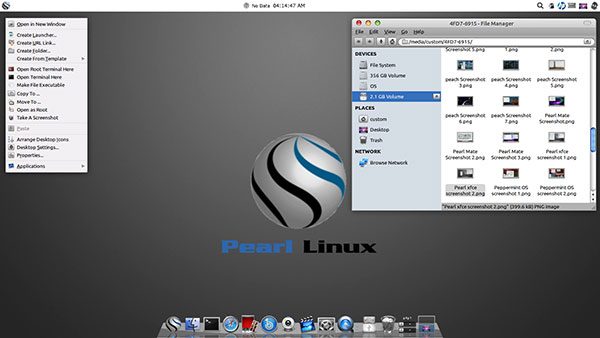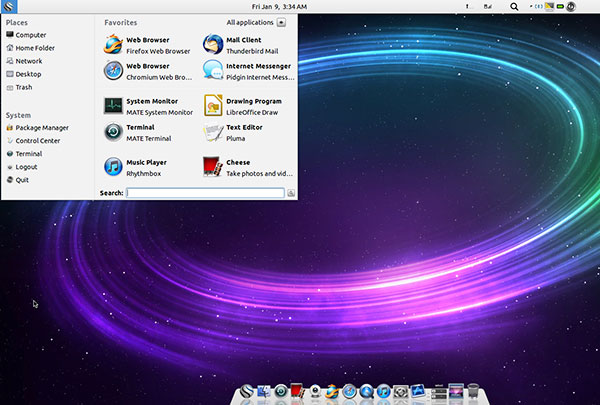
![]()
If you favor the OS X environment, Pearl OS might be a Linux distro to feed your fancy.Pearl OS is a revival of the discontinued Pear OS distro. Pearl picks up where Pear left off in early 2014.
Pearl OS has two desktop versions: XFCE and MATE. Both are based on Ubuntu Linux distro version 14.04 Mini release. The two flavors of Pearl OS are customized to look and act like the OS X operating system.
But Pearl is Linux and not OS X. This distro runs Debian-based Linux applications. It does not run OS X software or have actual OS X functions.
In fact, except for a few cosmetic touches, Pearl OS is not unlike other Linux distros that use the MATE or XFCE desktops. For that matter, it is very similar to Linux distros that run the Docky application launcher at the bottom of the screen.

The overall design steps away from the OS X look and feel when you open the menus. Pearl OS uses a Main Menu in the style of the Windows Vista OS. This XFCE release was last updated on Dec. 10. The MATE version was last updated on Dec. 17.
Under the Hood
Pearl OS is young but still impressive. Its two desktops have distinct differences. Both adhere to a carefully orchestrated design. Each has the expected user interface traits of the specific desktop.
If you have a strong need to maximize your hardware’s use of the OS, defer to the Pearl MATE 1.0 version. At least it is 64-bit. The Pearl XFCE 1.0 release is strictly 32-bit.
An LXDE version of Pearl OS is rumored to be planned. But no timeline exists for its release.
Both versions of Pearl OS use the Compiz window manager. Compiz is an OpenGL compositing manager. It has a flexible plug-in system and runs on most graphics hardware.
Compiz brings a bit more eye candy to both XFCE and MATE within the Pearl OS. For instance, you can activate the magic lamp minimizing effects to simulate the Genie effect and the wobbly windows effect. These and a host of other Compiz tricks are a possible advantage to using this new particular flavor of Linux.
If you adhere to the more purist mentality of GNOME 2, you can get that level of functionality in Pearl OS by switching to the MATE window manager.

Software Supply
The installed software differs a bit depending on whether you install the XFCE or the MATE desktop. Both versions include a new application browser on the bottom dock as an alternative to the main menu. Also used with both versions is the MDM Display Manager.
The XFCE version has the right-click menu anywhere on the desktop and uses the Thunar file manager. These are not MATE features. The standard MATE file manager, Caja, and the XFCE Thunar file manager both are included in the MATE release.
The XFCE desktop comes stocked with the LibreOffice Suite and Abiword. Its Multimedia software includes Handbrake, Banshee, VLC, Totem, Clementine and Audacity. Graphics packages include GIMP and Inkscape.
The Chromium (not Google Chrome) and Mozilla Seamonkey browsers are installed. Other networking software includes Etherape, Filezilla, Transmission and Pidgin.
The MATE version has a slightly different software inventory. It pairs the Chromium browser with Mozilla’s Firefox browser. It does not include the Abiword word processor. In many instances, the typical MATE packages are included as replacements for standard XFCE packages.
Performance
I was generally pleased with both versions of the latest Pearl OS release. For such a newcomer, the look and feel, and the stability, were much better than my expectations.
That said, I was surprised by my reaction to the finessing done with MATE in this rendition. In most of my forays into Linux distro newcomers, I tend to favor the XFCE implementation rather than that of MATE. But MATE was much better in Pearl OS.
Two reasons support this conclusion. The first is the Docky bar in Pearl OS’s XFCE version. Half of the time when the monitor went dark or I closed the lid to sleep the display, the Docky bar would disappear and not return. This did not happen in the MATE desktop.
The second reason is the wireless network connection. The XFCE configuration lacked drivers to see the Intel Centrino hardware on my test laptop. The system reported that no other drivers were available. But when I ran MATE, the wireless connection loaded and only needed the network password to connect.
Bottom Line
My only other complaint with Pearl OS 1.0 involved installation issues. The ISO file took an unusually long time to burn to DVD for both versions. The size was not atypical in either case. One was 1.6 GB; the other was 1.7 GB.
Add to that some fussiness with the graphics adapter on two of my test machines. After the splash screen loaded from the DVD live session, the screen froze repeatedly.
All in all, Pearl OS is a promising Linux distro — although it has a long way to go to measure up to more mature distro alternatives. The implementation of the OS X look and feel falls far short of the successes of the now defunct Pear OS.
Whether new users come from a Mac or Windows background, Pearl OS can be an easy transition to the Linux platform. If I were not so finicky in my preferences for Linux desktop alternatives, Pearl might be a good change of pace on one of my work machines.
One final tip: If you miss the fine print on the Sourceforge download screen, you must use the word “custom” for the user name and just hit the enter key for the password. Otherwise, you will not get beyond the login screen on the DVD installation.
Want to Suggest a Review?
Is there a Linux software application or distro you’d like to suggest for review? Something you love or would like to get to know?
Please email your ideas to me, and I’ll consider them for a future Linux Picks and Pans column.
And use the Talkback feature below to add your comments!






















































I downloaded and burnt Pearl to a USB key. It is a very nice Distro, quite lightweight and fast. Well worth giving it a try.
No that much – the wireless connectivity is found and needs manual setup to complete the connectivity. None of the distros found that much difficulty – this is basic.
Frequent disappearance of Docky menu at the bottom !!.
Much more to improve, not enough with cosmetic look. The elementary OS much better when compare to Pearl OS, Pear OS also looks same